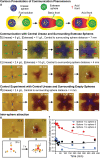Feedback and Communication in Active Hydrogel Spheres with pH Fronts: Facile Approaches to Grow Soft Hydrogel Structures
- PMID: 34347941
- PMCID: PMC8518392
- DOI: 10.1002/anie.202109735
Feedback and Communication in Active Hydrogel Spheres with pH Fronts: Facile Approaches to Grow Soft Hydrogel Structures
Abstract
Compartmentalized reaction networks regulating signal processing, communication and pattern formation are central to living systems. Towards achieving life-like materials, we compartmentalized urea-urease and more complex urea-urease/ester-esterase pH-feedback reaction networks into hydrogel spheres and investigate how fuel-driven pH fronts can be sent out from these spheres and regulated by internal reaction networks. Membrane characteristics are installed by covering urease spheres with responsive hydrogel shells. We then encapsulate the two networks (urea-urease and ester-esterase) separately into different hydrogel spheres to devise communication, pattern formation and attraction. Moreover, these pH fronts and patterns can be used for self-growing hydrogels, and for developing complex geometries from non-injectable hydrogels without 3D printing tools. This study opens possibilities for compartmentalized feedback reactions and their use in next generation materials fabrication.
Keywords: chemical reaction networks; hydrogels; life-like systems; pH feedback system; supramolecular chemistry.
© 2021 The Authors. Angewandte Chemie International Edition published by Wiley-VCH GmbH.
Conflict of interest statement
The authors declare no conflict of interest.
Figures







Similar articles
-
Antagonistic Enzymes in a Biocatalytic pH Feedback System Program Autonomous DNA Hydrogel Life Cycles.Nano Lett. 2017 Aug 9;17(8):4989-4995. doi: 10.1021/acs.nanolett.7b02165. Epub 2017 Jul 3. Nano Lett. 2017. PMID: 28656771
-
Urea-Urease Reaction in Controlling Properties of Supramolecular Hydrogels: Pros and Cons.Chemistry. 2021 Jun 21;27(35):8928-8939. doi: 10.1002/chem.202100490. Epub 2021 May 13. Chemistry. 2021. PMID: 33861488 Free PMC article. Review.
-
Fuel-Driven and Enzyme-Regulated Redox-Responsive Supramolecular Hydrogels.Angew Chem Int Ed Engl. 2021 Sep 13;60(38):21062-21068. doi: 10.1002/anie.202107917. Epub 2021 Aug 11. Angew Chem Int Ed Engl. 2021. PMID: 34252251 Free PMC article.
-
3D Printable Active Hydrogels with Supramolecular Additive-Driven Adaptiveness.Small. 2024 Jul;20(28):e2311164. doi: 10.1002/smll.202311164. Epub 2024 Jan 31. Small. 2024. PMID: 38295083
-
Supramolecular Hydrogels Based on DNA Self-Assembly.Acc Chem Res. 2017 Apr 18;50(4):659-668. doi: 10.1021/acs.accounts.6b00524. Epub 2017 Mar 16. Acc Chem Res. 2017. PMID: 28299927 Review.
Cited by
-
Membrane Transport Modulates the pH-Regulated Feedback of an Enzyme Reaction Confined within Lipid Vesicles.ACS Nano. 2025 Mar 18;19(10):9814-9825. doi: 10.1021/acsnano.4c13048. Epub 2025 Mar 3. ACS Nano. 2025. PMID: 40029853 Free PMC article.
-
Nonlinear Transient Permeability in pH-Responsive Bicontinuous Nanospheres.J Am Chem Soc. 2023 Mar 30;145(15):8600-8. doi: 10.1021/jacs.3c01203. Online ahead of print. J Am Chem Soc. 2023. PMID: 36995949 Free PMC article.
-
Using a biocatalyzed reaction cycle for transient and pH-dependent host-guest supramolecular hydrogels.J Mater Chem B. 2024 May 15;12(19):4666-4672. doi: 10.1039/d4tb00545g. J Mater Chem B. 2024. PMID: 38647183 Free PMC article.
-
Fabricating Shaped and Patterned Supramolecular Multigelator Objects via Diffusion-Adhesion Gel Assembly.J Am Chem Soc. 2023 Nov 8;145(44):24061-24070. doi: 10.1021/jacs.3c07376. Epub 2023 Oct 27. J Am Chem Soc. 2023. PMID: 37885219 Free PMC article.
-
Soft Materials with Time-Programmed Changes in Physical Properties through Lyotropic Phase Transitions Induced by pH-Changing Reactions.ACS Appl Mater Interfaces. 2024 Apr 17;16(15):19585-19593. doi: 10.1021/acsami.4c01455. Epub 2024 Apr 5. ACS Appl Mater Interfaces. 2024. PMID: 38579106 Free PMC article.
References
-
- Meinhardt H. in Current Topics in Developmental Biology, Vol. 81 (Eds.: Schnell S., Maini P. K., Newman S. A., Newman T. J.), Academic Press, New York, 2008, pp. 1–63.
-
- Bean B. P., Nat. Rev. Neurosci. 2007, 8, 451–465. - PubMed
-
- Epstein I. R., Pojman J. A., An Introduction to Nonlinear Chemical Dynamics: Oscillations, Waves, Patterns, and Chaos, Oxford University Press, New York, 1998.
Publication types
LinkOut - more resources
Full Text Sources

